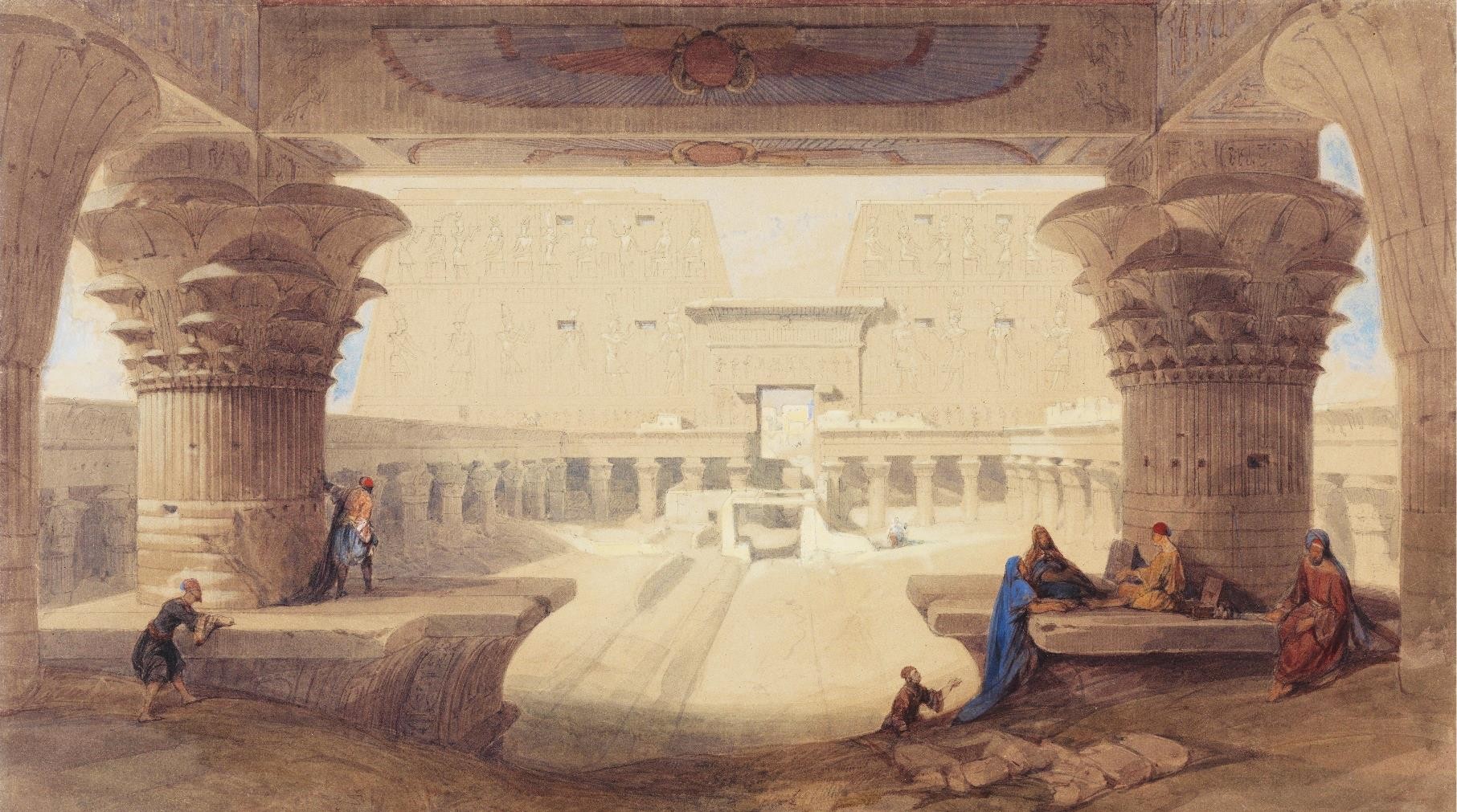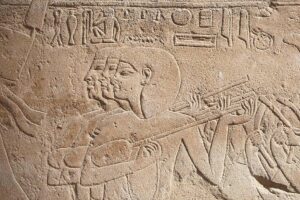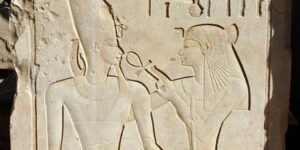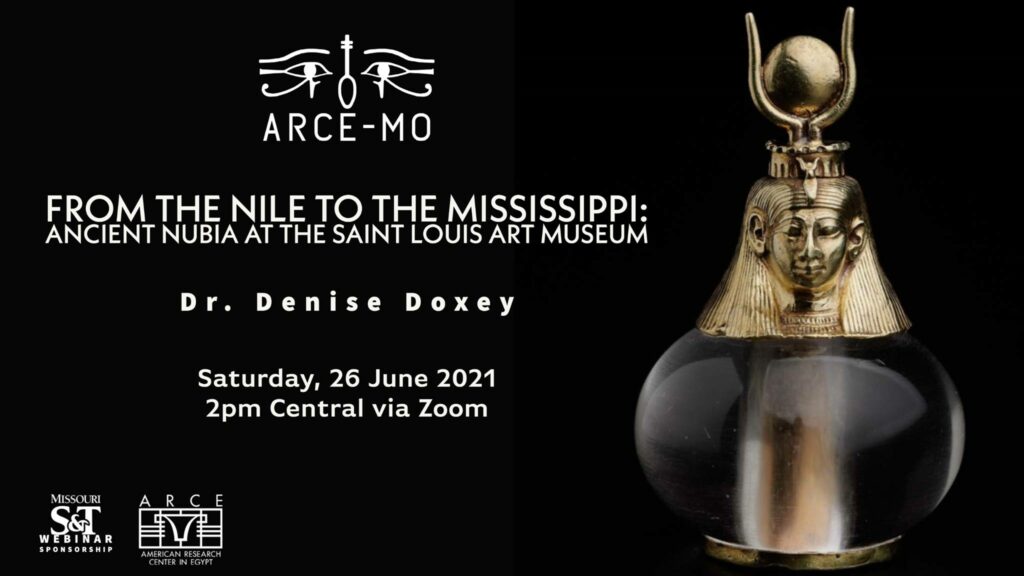
Online events in juni
Zaterdag 5 juni
Museumnacht Leiden Online
met o.a. Op zoek naar Toetanchamon in het Rijksmuseum van Oudheden
Kosten: €5
Zondag 6 juni, 19.00 uur
Bes-like figures in the ancient Egyptian Book of the Dead
Dr. Rita Lucarelli
Bes was a popular god in ancient Egypt and he still is today. Less known are instead some apotropaic Bes-like figures occurring in the vignettes of spells belonging to the corpus of the Book of the Dead, especially on papyrus, and which play the function of demonic guardians of the netherworld. In this lecture, these figures will be analyzed and discussed in order to understand their (benevolent or malevolent) agency within the heterogeneous divine and demonic population of the Realm of the Dead.
 Maandag 7 juni, 18.15 uur
Maandag 7 juni, 18.15 uur
Musik: ein fast unsichtbares Fundament der altägyptischen Kultur
Prof. Dr. John Baines (Oxford)
Musik und Tanz sind integrale Bestandteile des Menschseins. Das galt für die Alten Ägypter wie für uns heute. In Ägypten war Musik unverzichtbarer Bestandteil bei Festen, Riten und beim Militär: In verschiedenen Epochen übernahmen Hofleute die Rolle von Musikern, Werke der Literatur wurden musikalisch aufgeführt. Durch Musik konnten Ideen und Emotionen ausgedrückt werden, die sonst fast nicht öffentlich ausgesprochen wurden. Trotz ihrer Bedeutung wird die Musik relativ wenig von Ägyptologen berücksichtigt. Der Klang der ägyptischen Musik mag fast unerreichbar sein, aber reiche Quellen bieten einen Zugang zum musikalischen Leben.
Dinsdag 8 juni, 17.15 uur
Bes in Bahariya
Françoise Labrique (University of Cologne / Université libre de Bruxelles)
From the XXVIth dynasty to the Period of the Roman Empire, monumental remains in the Bahariya-oasis, despite their bad state, show the prestige of the god Bes as a warrior, a musician, a protector, an atlant. Was he the object of a specific cult? After a synthesis of the archaeological finds of these last years, we will try to define his theological role.
Dinsdag 8 juni, 18.00 uur
From the Museum back to the tomb: the virtual rejoining of a sarcophagus and its burial in 26th dynasty Saqqara
Rita Lucarelli
The Late Period inner sarcophagus of “chief physician” and “overseer of the Temehu (Libyan mercenaries)” Psamtek, found in 1900 in Psamtek’s tomb south of the Unas pyramid at Saqqara, is now on public display in the Phoebe A. Hearst Museum of Anthropology in Berkeley, California (PAHMA 5-522). Like many museum objects, its modern display cannot adequately replicate aspects of its original archaeological context — in a deep rock-cut shaft, nestled among hundreds of impressive elite tombs at the necropolis.
In order to virtually re-place the sarcophagus in its original context, a joint team from the University of California, Berkeley and Santa Cruz, is developing a dynamic VR-headset experience that combines a 3D reconstruction model of Saqqara with a photogrammetric model of the sarcophagus. In this presentation, I will provide a demo of the VR headset application (under development), present the “Book of the Dead in 3D project”, aiming at building a database of annotated 3D coffins as the one of Psamtek, and describe the technological and intellectual challenges of combining multiple types of data in the application.
Woensdag 9 juni, 18.00 uur
Museums in Egypt: past, present, future
Salima Ikram (Cairo)
11-12 juni
Online workshop: Researching the History of Egyptology
Kosten: £10
Many themes have dominated research into the history of Egyptology including the Napoleonic Description de l’Egypte, the decipherment of hieroglyphs, and the explorations of early travellers. But increasingly, broader themes relating to the history of Egyptology are being discussed including the influence of political conditions on the development of early Egyptology in the 19th century, and the work of the first Egyptologists as seen in their original archives.
Dinsdag 15 juni, 19.30 uur
Het linnen van de farao’s: de textielcollectie van Alfred Wiedemann in Brussel en Leiden
Veerle van Kersen MA (KU Leuven)
Kosten: gratis voor donateurs en studenten, €5 voor niet-donateurs
Linnen vervulde millennia lang een belangrijke rol in de Egyptische samenleving. Naast het gebruik in het dagelijks leven was het ook een onmisbaar element bij religieuze en funeraire praktijken, zoals het mummificatieritueel. Tot voor kort zagen de meeste egyptologen mummiewindsels echter als onbelangrijk, en niet de moeite om te bewaren. Veel funerair textiel werd zo weggegooid, of in stukjes geknipt en verhandeld als souvenir.
De Duitse egyptoloog Alfred Wiedemann verzamelde deze stukjes textiel, en schonk rond 1900 een deel van zijn collectie aan de musea in Brussel en Leiden. In deze lezing zullen we de herkomst van deze fragmenten nader bekijken, en onderzoeken hoe ze door de antiquiteitenhandel in Europa zijn beland. Daarnaast bespreken we ook de resultaten van een technische analyse van deze fragmenten. De informatie verweven in dit textiel geeft ons namelijk nieuwe inzichten over de evolutie van textieltechnologie in Egypte.
Donderdag 17 juni, 18.00 uur
The Museo Egizio’s current research at Deir el-Medina
Dr Cedric Gobeil
Within the framework of the French Archaeological mission at Deir El-Medina carried by the IFAO, the Museo Egizio of Turin is conducting research on a few Ramesside tombs located in the Western necropolis. These tombs have been chosen based on the many artifacts that belonged to the owners of these tombs and are now kept in the museum. In addition to giving the opportunity to perform a study on these fragile structures using new technologies, this fieldwork is a unique chance to recontextualize many objects of the museum’s collection by shedding a new and fresh light on them. During this talk, viewers will have the chance to get a first glimpse at this work in progress.
Facebook Live (link to be posted)
 Donderdag 17 juni, 19.00 uur
Donderdag 17 juni, 19.00 uur
Hatshepsut and the Temple of Mut
Prof. Betsy Bryan
By 1470 B.C.E., Hatshepsut emerged as King, technically reigning alongside her stepson and nephew Thutmose III. As he was still a youth, Hatshepsut dominated their coregency. As ruler she constructed numerous edifices honoring the great gods of Thebes, Amun, and Mut. For Mut, she rebuilt the temple and renewed festival rites involving sacred drunkenness. Hatshepsut’s devotion to the Mut Temple connects her to Karnak, Luxor, and her glorious Deir el Bahri across the Nile.
Zaterdag 19 juni
Sudan Day 2021
Registreer uiterlijk 18 juni via Sudantag-Berlin-2021@dainst.de
Zaterdag 19 juni, 15.30 uur
The Funerary Monuments of Hatshepsut and Senenmut
Prof. Aidan Dodson
Kosten: £5
Hatshepsut’s reign marked an important horizon in the development of Egyptian royal funerary arrangements, with the definitive adoption of the Valley of the Kings as the kingly cemetery, and the first ‘mature’ royal memorial temple. In the private sphere, the funerary arrangements of her close associate Senenmut show important features, some of which are seemingly unique for a private person. This afternoon we will therefore explore their monuments and what they tell us about not only Egyptian funerary archaeology, but also what they may say about the much-debated nature of the their personal relationship.
Zaterdag 19 juni, 19.00 uur
The History and conservation of Khonsu Temple
Dr. Nicholas Warner
In 2020, ARCE prioritized completing the conservation of this significant Pharaonic monument starting in the fall of 2021 with complete documentation using 3D laser scanning. The work is scheduled to continue for at least four years. It will initially focus on exterior structural repairs and consolidation, followed by conserving the remaining un-treated polychrome painted surfaces within the temple and further training for local conservators and site managers.
Dinsdag 22 juni, 12.00 uur
The EES Amara West excavations
Dr Tomomi Fushiya
Archaeological practice is not isolated from society. Relationships are forged in reflection of the time. Led by Herbert W. Fairman, the EES expedition conducted the first systematic excavation of Amara West from 1938, during the Anglo-Egyptian Condominium period. This lecture looks at the relationship of the EES team, Quftis brought from Egypt, and local Nubian communities – all of whom were involved in the Amara West excavation – based on study of archival records in the EES Lucy Gura Archive, and memories of former Sudanese workers who still live around the site which I recorded during fieldwork with the British Museum’s Amara West Research Project (2015-2018).
Dinsdag 22 juni, 20.00 uur
De Belgische opgravingen in de rotsnecropool van Elkab (1986-1999)
Stan Hendrickx (UHasselt/PXL-MAD)
Kosten: €4
Tussen 1986 en 1999 onderzocht het Comité voor Belgische Opgravingen in Egypte een aantal rotsgraven uit het late Oude Rijk in de rotsnecropool te Elkab. De graven bevinden zich in het Noordwestelijke deel van de necropool, in het zicht van het woongebied aan de rand van de Nijl. Van uitzonderlijk belang is het feit dat sommige graven in rechtstreeks verband kunnen gebracht worden met inscripties in de Wadi Hellal, drie kilometer verder in de woestijn. De teksten verwijzen naar priesters van Nekhbet: minstens twee graven behoorden aan deze priesters toe, waaronder dat van “Sawikai” (sA-w(i)k(A=i), het enige graf dat ook gedecoreerd werd. Daarnaast werd bovenop de heuvel met de rotsgraven ook een mastaba uit de 3de dynastie opgegraven. Dit uitzonderlijke monument wijst op het grote belang van Elkab gedurende het vroege Oude Rijk.
Zaterdag 26 juni, 21.00 uur
From the Nile to the Mississippi: Ancient Nubia at the Saint Louis Art Museum
Dr. Denise Doxey
Nubia: Treasures of Ancient Africa, now on view at the Saint Louis Art Museum, explores the powerful but enigmatic kingdoms of ancient Nubia through their artistic achievements, including magnificent jewelry, pottery, sculpture, metalwork, and more. Drawn entirely from the collection of the Museum of Fine Arts, Boston, it focuses on the sites of Kerma, Napata, and Meroe, spanning some 2,000 years, from about 1700 BCE into the fourth century CE.
Through Nubian art, the exhibition also examines concepts of power, representation, and cultural bias in the ancient world, in the early 20th century, and today. Join guest curator Dr. Denise Doxey for a virtual tour of the exhibition and a discussion of the behind-the-scenes process of developing it.
Dinsdag 29 juni, 18.00 uur
Dahshur before Snefru: The pre-pyramid cultural landscape of Dahshur
Lea Rees (Freie Universität Berlin/University of Cambridge)
The pyramid site of Dahshur is traditionally associated with the pyramids built by king Snefru, the founder of the 4th Dynasty. Popular as well as scientific literature often give the impression that the pyramids of the Old Kingdom were built on ‘virgin ground’, untouched by human activity before the rulers decided to erect their monuments at this very location. But in fact, all of the pyramid sites of the Memphite necropolis had already served as an elite burial ground in Pre- and Early Dynastic times. Only at Dahshur such early material seemed to be missing. However, a re-evaluation of excavations carried out in the late 19th century as well as archaeological discoveries of the last 30 years make it possible to draw a provisional picture of the pre-pyramid cultural landscape of Dahshur.


